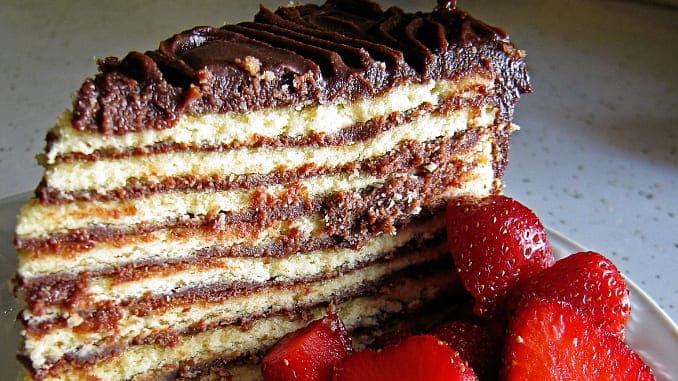The Enigmatic Origin of Maryland’s Most Storied Dessert
Photo by Jane Thomas/Creative Commons Food Features dessert
About twelve miles off the coast of Maryland, there’s a tiny time capsule floating in the Tangier Sound, a speck of land that’s been inhabited for more than 300 years and a place that’s steadily disappearing. On a map, Smith Island is a smattering of tiny smudges engulfed by the vastness of America’s largest estuary, the Chesapeake Bay. The last inhabited island in Maryland without a link to the mainland, today, Smith Island is one of just three islands in the entire mid-Atlantic region that still has year-round residents. Groceries and mail arrive by boat, and the fastest way for visitors to reach the island is on a ferry from Crisfield, the closet mainland town.
Smith Island is actually a bit of a misnomer—the place is technically an archipelago, a smattering of marsh-tufted barrier islands perforated by tidal creeks. The entire cluster of islands is about 8,000 acres, but only about 900 acres are truly habitable—and dry land is vanishing. These days, there are about 200 year-round residents in the archipelago’s trio of communities: Ewell, Rhodes Point and Tylerton. The region may be famed for its crabs and oysters, but more recently, a dessert has drawn visiting gastronomers: the Smith Island Cake.
A Mysterious Origin
A multi-layered confection with equal parts cake and icing, a traditional Smith Island Cake has at least eight layers cemented together with fudgy frosting. The zebra-striped delicacy was declared the official State Dessert of Maryland in 2008. Champions of the cake served pieces to every member of the legislature, dishing up more than a thousand slices in the process. In the end, House Bill 315 passed with bipartisan support.
Still, the origin of the artfully tiered dessert and the reason for the layering remains an enigma. According to Smith Islanders like Mary Ada Marshall, a baker extraordinaire who contributed some of the cakes catalyzing House Bill 315, recipes for the dessert have been passed down for generations but never attributed to a specific baker.
The first time a recipe for the cake appeared in print was in the second edition of Frances Kitching’s seminal Smith Island cookbook, published in 1994. The dessert was inexplicably absent from the original version, but in the second printing, Kitching included a recipe for dessert: ten layers of yellow cakes slathered with chocolate frosting.
The delicacy has been compared to a traditional torte, but Smith Islanders have taken layering to the extreme, and the reasoning for the stacked layers remains the subject of debate.
Some local bakers have admitted the layers are a way to showcase cake-making prowess. But there are other plausible explanations too. For instance, visiting historians have posited the thin layers are just practical, a harbinger of the days when the cakes were still baked in wood-burning stoves, before electricity arrived on Smith Island in the late 1950s. The frosting ensconcing the cakes also makes the dessert sturdy and keeps individual slices from drying out—perfect for long stints on the water, especially during the winter oyster season. Another theory? The standard recipe call for three sticks of butter, meaning every piece is packed with calories.
Let Them Eat Cake
Culinary traditions have been parlayed into businesses more than once on Smith Island. For generations, women on the archipelago spent summer and early fall picking the blue crabs harvested by the island’s watermen, and the hand-picked crabmeat was a pillar of the local economy. When the authorities cracked down on the cottage industry, a dozen local women led by Tylerton-resident Janice Marshall united to form the Smith Island Crabmeat Co-op in 1996.
A little more than a decade later, after Smith Island cake was elevated to status of state dessert, the recognition helped spawn another industry on the island: baking. In 2009, Eastern Shore native Brian Murphy tapped into the island’s culinary heritage, opening the Smith Island Baking Company in Ewell. But the operation relocated to Crisfield in 2015, driven ashore in part by the logistical challenges of shipping five-pound cakes from an island. Three years later, the Smith Island Bakery filled the void, setting up shop in Ewell in 2018. Transplants from mainland Maryland, owners Kathey and Darren Jones, were so smitten with Smith Island after a day trip to the archipelago that they decided to relocate. And today, their bakery ships more a dozen varieties of the iconic cake all over country—and still relies on the island’s daily mail boat.
Running Out of Time
Still, the origin of the dessert will probably remain a mystery. Like many of the remaining landmasses peppering the Chesapeake Bay, Smith Island is steadily disappearing. Due to a combination of factors, including land subsidence and climate change, the sea level is rising at a rate twice the global average in the Chesapeake Bay region. More than 400 of the Bay’s islands have disappeared since the 1600s, and according to regional projections, the sea level could rise by 2.1 feet by 2050. In fact, Smith Island could be underwater by the end of the century, meeting the same fate as once-inhabited atolls like Holland Island and Sharps Island, now long gone.
But for now, Smith Island and its storied dessert are still just a ferry ride away.